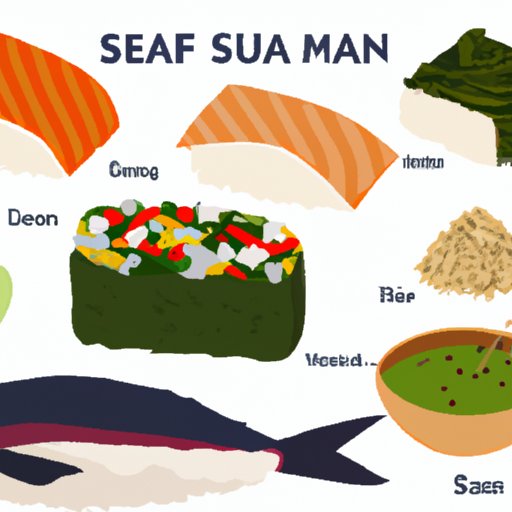Introduction
Japanese cuisine is well-known for its flavorful dishes, fresh ingredients, and artful presentation. From sushi and tempura to ramen and soba, there’s a seemingly endless variety of dishes that make up Japanese cuisine. But beyond its delicious flavor, is Japanese food actually healthy? This article will explore the nutritional benefits and potential risks associated with eating Japanese food, as well as provide tips for making healthier versions of traditional recipes at home.
Exploring the Nutritional Benefits of Japanese Cuisine
One of the primary benefits of eating Japanese food is its use of nutrient-dense ingredients. These include fresh vegetables like daikon radish, carrots, and mushrooms; leafy greens like spinach and kale; and seafood like salmon, tuna, and squid. All of these ingredients are packed with essential vitamins and minerals, as well as fiber and protein. In fact, according to a study published in the Asia Pacific Journal of Clinical Nutrition, “the average daily intake of most nutrients was higher among the Japanese than other nationalities.”
In addition to being nutrient-dense, Japanese food is also typically low in calories and high in protein. This makes it an ideal choice for those looking to maintain a healthy weight or build muscle. For example, a typical bowl of miso soup contains just 70 calories, while a plate of teriyaki chicken provides around 200 calories and 20 grams of protein.

Examining the Health Risks Associated with Eating Japanese Food
While Japanese food can be a nutritious and satisfying meal option, there are some potential health risks to consider. One of the most common is the potential for allergens. Many traditional Japanese dishes contain ingredients like wheat, soy, shellfish, and eggs, which can trigger allergic reactions in some individuals. It’s important to be aware of any potential allergens when ordering or preparing Japanese food.
Another potential risk associated with eating Japanese food is its high salt content. Many traditional dishes contain large amounts of sodium, which can increase blood pressure and put strain on the heart. To reduce the amount of salt in your diet, try using low-sodium soy sauce, adding less salt to recipes, and avoiding dishes that are particularly high in sodium, such as tempura.

How to Make Healthy Japanese Dishes at Home
If you’re a fan of Japanese food but want to make it healthier, there are several simple swaps you can make. For example, instead of white rice, try brown rice or quinoa. Or instead of deep-frying your food, opt for baking or grilling. You can also substitute healthier ingredients, such as olive oil instead of vegetable oil, and tofu instead of meat.
When it comes to modifying traditional recipes, the key is to keep the flavors and textures intact while making healthier substitutions. For instance, if you’re making teriyaki chicken, try using low-sodium soy sauce, honey instead of sugar, and skinless chicken breasts instead of thighs. With a few simple switches, you can enjoy all the flavors of your favorite Japanese dishes without compromising your health.
The Pros and Cons of Eating Traditional Japanese Meals
Traditional Japanese meals offer a variety of flavors and textures that can be both satisfying and nutritious. However, many of these dishes are high in sodium, fat, and sugar, which can have a negative impact on overall health. Additionally, the use of refined carbohydrates such as white rice and noodles can lead to spikes in blood sugar levels.
Comparing the Health Benefits of Japanese vs. Western Diets
When it comes to comparing the health benefits of Japanese and Western diets, there are some notable differences. For starters, Japanese diets tend to be higher in fiber and lower in saturated fat than Western diets. Additionally, Japanese diets are generally higher in omega-3 fatty acids, which have been linked to a reduced risk of cardiovascular disease. On the other hand, Western diets are typically higher in protein and calcium, two essential nutrients for bone health.
In terms of macronutrients, Japanese diets tend to be higher in carbohydrates and lower in fat than Western diets. However, when it comes to micronutrients, both diets offer similar levels of vitamins and minerals. So while there are some key differences between the two diets, both can provide essential nutrients for optimal health.

An Overview of Commonly Used Ingredients in Japanese Cooking
A wide variety of ingredients are used in Japanese cooking, each of which offers its own unique nutritional benefits. Rice is one of the most commonly used ingredients, providing complex carbohydrates and B vitamins. Soy products, such as tofu and edamame, are also popular, offering plant-based sources of protein, fiber, and iron. Fish is another staple, providing essential omega-3 fatty acids and vitamin D.
Seaweed is another common ingredient used in Japanese cuisine. Rich in minerals like calcium and iodine, seaweed is a great source of essential nutrients. It’s also low in calories and contains anti-inflammatory compounds that may help lower the risk of certain diseases.
Conclusion
Overall, Japanese cuisine can be a nutritious and flavorful way to enjoy a meal. Its use of nutrient-dense ingredients, low calorie count, and high protein content make it a great option for those looking to maintain their health. However, potential allergens and high salt content should be taken into consideration. By making simple swaps and substituting healthier ingredients, you can still enjoy the flavors of traditional Japanese dishes while reaping the nutritional benefits.
(Note: Is this article not meeting your expectations? Do you have knowledge or insights to share? Unlock new opportunities and expand your reach by joining our authors team. Click Registration to join us and share your expertise with our readers.)
